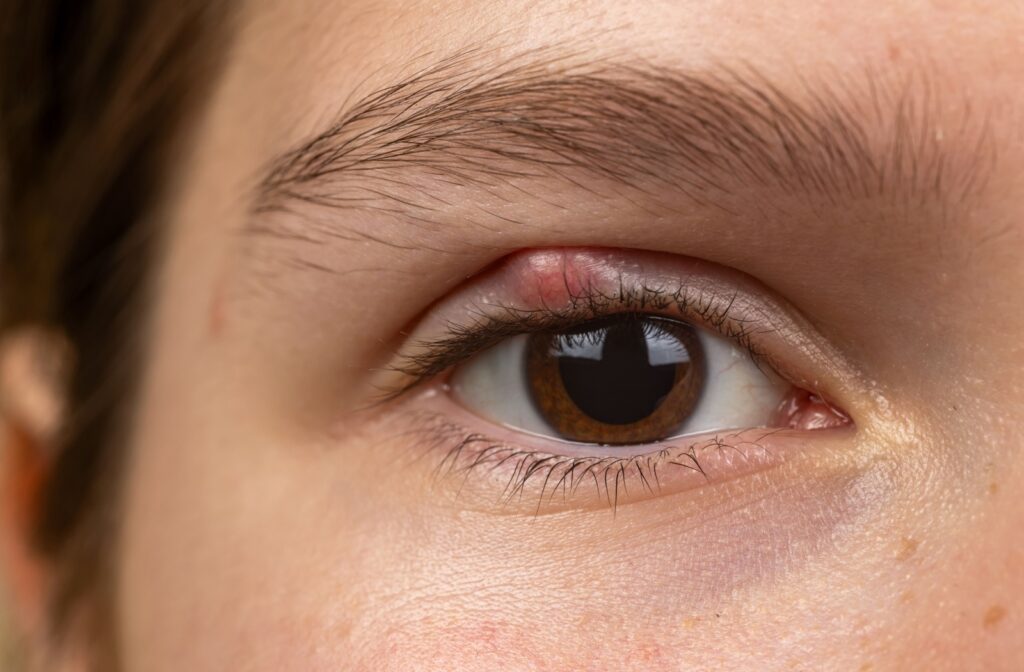You’re going through a particularly stressful time, when suddenly a small, sore bump appears on your eyelid. You might wonder if the two events are connected. It’s a common question from people who are balancing busy lives with the need for routine eye care.
While stress does not directly cause a stye, it can weaken your body’s defenses and make you more susceptible to one. Let’s explore how stress can affect your vision and discuss how you can care for your eyes. Understanding this link is a great first step toward proactive eye health.
What Is a Stye?
A stye, also called a hordeolum, is a red, tender lump that forms near the edge of your eyelid. It often looks like a small pimple. Styes occur when an oil gland in your eyelid gets blocked, allowing bacteria to grow.
Styes can develop on the outside or inside of an eyelid, though they typically only affect one eye at a time. While they can be uncomfortable, they’re very common and usually not serious. Recognizing the signs early can help you manage the discomfort.
Common Stye Symptoms
You may have a stye if you notice any of these signs:
- A painful red bump along your eyelid
- Swelling around the bump or of the entire eyelid
- A small spot of pus at the center of the bump
- A scratchy feeling, like something is in your eye
- Sensitivity to light
- Crustiness along the eyelid
- Watery eyes
The Link Between Stress & Styes
The connection between feeling stressed and getting a stye is indirect. High levels of stress can suppress your immune system—your body’s natural defense against infection. When your immune system is down, it’s harder for your body to fight off the common bacteria that can lead to a stye.
Forgetting simple hygiene habits, like washing your hands frequently or properly removing makeup to prevent eye irritation, also becomes more common when you’re overwhelmed. These small lapses can create an opportunity for bacteria to clog an oil gland.
Can Stress Cause Your Eyelids to Swell?
Inflammation from bacterial infection is what causes the puffiness that you see and feel when you have a stye. Therefore, because stress can contribute to the conditions that allow styes to form, stress could be said to indirectly contribute to swelling of your eyelid.
Other Causes & Risk Factors for Styes
While stress can lower your guard, other factors are more directly responsible for causing a stye. Understanding these factors can help you protect your eye health.
You may be more likely to get a stye if you have any of the following conditions:
- Blepharitis: This is a condition that involves chronic eyelid inflammation.
- Certain skin conditions: Rosacea or seborrheic dermatitis can increase your risk.
- Health conditions: Diabetes can make you more prone to different types of infections, making annual diabetic eye exams crucial.
- Hormonal changes: Fluctuations in hormones can sometimes be a contributing factor.
- Poor hygiene: Touching your eyes with unwashed hands can transfer bacteria.
- Makeup habits: Sleeping in makeup or using old products can clog oil glands.
- Contact lenses: Not following proper contact lens care guidelines can introduce bacteria to your eyes.

How to Manage & Prevent Styes
In many cases, a stye will get better on its own within a week with some simple care at home. It’s important to let it heal naturally without squeezing or trying to pop it. Squeezing a stye can spread the infection and make the situation worse.
While your stye heals, avoid wearing contact lenses and eye makeup. This helps keep the area clean. Make sure to wash your hands before and after touching your face. Doing so helps contain the bacteria and support the healing process.
Simple Home Remedies
To help relieve discomfort and encourage healing, you can try a few things at home. These methods are gentle and can help the stye drain on its own.
- Apply a clean, warm compress to the affected eye for 10 to 15 minutes, three to four times a day.
- Gently wash your eyelids with a mild cleanser.
- Use a saline solution to help keep the area clean.
- Take over-the-counter pain medication if the stye is painful.
Practice Good Eye Hygiene
Adopting good habits is one of the most effective ways to prevent styes from forming in the first place. A few small changes to your daily routine can make a big difference.
- Wash your hands thoroughly before you touch your eyes or handle contact lenses.
- Remove all eye makeup before you go to bed each night.
- Replace your mascara and eyeliner every three months to avoid bacterial growth.
- Avoid sharing makeup, towels, or pillowcases with others.
Manage Your Stress Levels
Since stress can weaken your immune response, finding healthy ways to manage is also important. A strong immune system is better prepared to fight off infections.
- Aim for seven to eight hours of quality sleep each night.
- Stay active with regular physical activity, which can help reduce stress hormones.
- Try mindfulness techniques like deep breathing or meditation to calm your mind.
- Take regular breaks from screens to avoid digital eye strain.
When to See Your Eye Doctor in Ladera Ranch
If your stye doesn’t improve after a few days of home care, or if it seems to be getting worse, you should seek professional advice. Your eye doctor can look at the issue and recommend the right course of action. Prompt attention can help you feel better sooner and prevent other issues.
You should schedule a visit with us if you experience any of the following signs. These symptoms suggest the infection may be more serious and require medical treatment.
- The pain or swelling increases after two to three days.
- The stye affects your vision.
- Your entire eye looks red, or the swelling is significant.
- Blisters form on your eyelid.
- The stye comes back frequently.
We can perform an eye disease diagnosis to determine if it’s a stye or another type of eye condition. Depending on your situation, we may suggest a prescription antibiotic ointment or eye drops to clear the infection. In some instances, we may perform a quick, in-office procedure to drain the stye, which can provide immediate relief.
At Total Vision Ladera Ranch, we are ready to care for each member of your family. Your eye health is important to us, and you don’t have to manage eye discomfort on your own. Come and see us today. We’re here to help!



